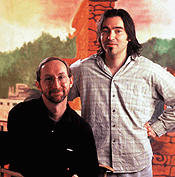El Dorado: The Old World
Meets the New in "Tradigital" Animation
(continued from page 1)
Prince Paved the Way
While The Prince of Egypt, DreamWorks' first traditionally
animated feature, may not have been the financial success that the
studio had hoped for, it has paid for itself in the long run by
serving as an artistic springboard for El Dorado, a much
bolder film with greater commercial possibilities.
James Williams concludes, "In terms of ground-breaking procedures
we didn't have to utilize so much new technology on this film. But
what we were able to do was to really hone our skills and use some
of the technology that we used only in the exceptional scenes in
The Prince of Egypt and pretty much use it throughout El
Dorado." By "exceptional" Williams means a blend
that fuses the artistic quality of two-dimensional paintings and
drawings with three-dimensional sets. The layout department created
over twenty 3D sets on El Dorado more than four times as
many as Prince.
Don Paul, who had previously served as co-head of the visual effects
department on Prince, also spoke of how that film influenced
the work on El Dorado, which he co-directed with Eric "Bibo"
Begeron. "There was a lot of technical ground-breaking we had
to do just to get the studio organized and get the type of platform
where we could actually create the film [Prince]. We went
through a lot of challenges visually for that film, but it established
a certain framework of what we would be able to use on this film
[El Dorado]."
 |
|
Co-directors
of The Road To El Dorado, Don Paul (left) and Eric
"Bibo" Bergeron (right).
|
While there may have been little ground-breaking
technology initiated for El Dorado, the blending of traditional
artists and digital artists or "tradigital" -- a word
coined by El Dorado's digital supervisor, Dan Phillips --
created a work that takes feature animation to a new level. It is
more than coincidental that just as the Old World meets the New
World in the film, traditional animation has been blended with digital
animation in the production. According to Don Paul, the effect was
intentional. "We tried to mix the two [traditional and digital]
so that it isn't one or the other. The thing that I enjoy about
the way the departments are forming here is that it's a mixture
of traditional people and digital people, and they're working together
to create the shots. What was really interesting about The Prince
of Egypt was we had more of the CG artists than the traditional
artists on that show. And because they had worked together for so
long, this show started to have its hybrid artists, where they were
both. You know, it used to be we'd have to hand off to one or the
other. But this new type of artist is starting to grow here, and
they usually have a couple of tool sets with them. It may be drawing
and it may be digital animation."
 |
|
Background
supervisor Kevin Turcotte (left), background painter Paul
Duncan (middle) and art director Paul Lasaine study some
of the landscapes for the film. TM & © 2000 DreamWorks
LLC.
|
Kevin Turcotte agrees with Paul. "Artists
have their own offices where they do the traditional paintings,
but they'll share computers for the digital part. There's a main
lab plus two smaller labs. So, they'll actually have two homes here."
Of the 18 background animators that Turcotte supervised, 15 were
"tradigital" hybrids and only three were purely digital.
"What's really unusual about this film, too, is that on The
Prince of Egypt, all of our background approvals were physical
backgrounds," Don Paul cited. "On this show [El Dorado],
everything was digital, so the background approvals were all on
monitor. It's kind of strange. This is the first show I've ever
worked on where you couldn't actually hold the painting [for approval]."
If audiences have as much fun watching El Dorado as the 95
animators at DreamWorks had creating it, the film should definitely
be a blockbuster. "It was actually much more fun [than Prince]
in some ways," Paul states. "We didn't have the same technical
hurdles that we had on the last show, and I think people generally
had a lot more fun doing the shots and exploring what potentials
the system we built had."

